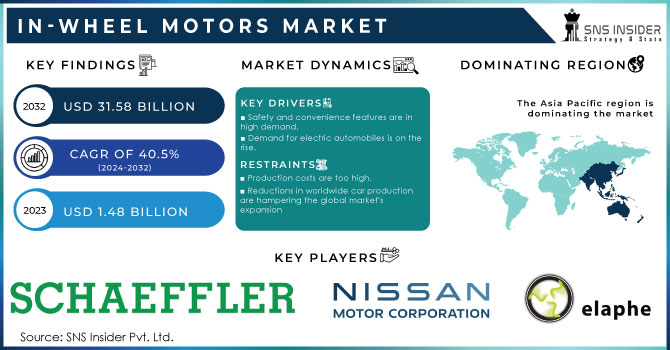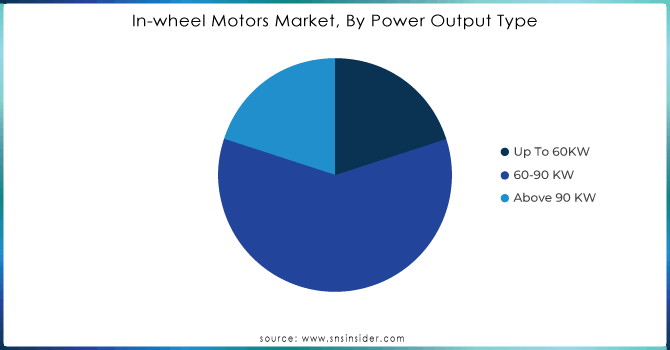In-wheel Motors Market Report Scope & Overview:

Get more information on In-wheel Motors Market - Request Sample Report
In-wheel Motors Market Size was valued at USD 1.48 billion in 2023 and is expected to reach USD 31.58 billion by 2032 and grow at a CAGR of 40.5% over the forecast period 2024-2032.
An in-wheel motor is an electric motor that is mounted directly on a wheel in order to provide direct propulsion to those wheels. It is a component of the drivetrain system of an electric car. The overall driving experience is enhanced, and additional power is produced as a result. Because power is transferred directly from the motor to the wheel via an in-wheel motor, the amount of distance that power must travel is cut down, which results in an increase in the motor's overall efficiency. In conventional electric vehicles, there was only one motor that was responsible for propelling all of the wheels of the vehicle. However, when the in-wheel motor system was introduced, independent motors were installed on the wheels of vehicles, and these motors were responsible for the individual operations of the vehicle. This motor supplies direct power to the wheel, which results in an improved reaction from the accelerator.
Among these, one of the main trends is the integration of in-wheel motors in EVs that has brilliant potential with regards to energy efficiency and driving dynamics. The concept of in-wheel motors has a contrasting outlook compared to the traditional powertrain because each wheel is powered directly, thereby reducing the loss in mechanics and offering finer control over vehicle dynamics. This concept can be highly applied to electric SUVs and trucks, where higher performance and efficiency are considered paramount. Another leading trend is the adoption of advanced materials and manufacturing processes to improve durability and efficiency in in-wheel motors. The usage of lightweight materials like high-strength aluminum alloy and carbon composite is on the rise with a focus on reducing overall motor weight, thus improving the range and handling of the vehicle. Moreover, there is development in thermal management systems that are leading to the disappearance of these heating problems that arise with high-power in-wheel motors, while ensuring reliability and performance in a wide range of driving conditions.
Besides, in-wheel motors are in demand because they offer more design flexibility for vehicles and allow the development of autonomous platforms that are more compact, efficient, and agile. The trend for smart cities and sustainable urban transportation conditions contributes to further support for the market, where the role of in-wheel motors is decisive in next-generation electric buses and shared mobility. In the future, electric mobility and transportation innovation will continue showing evolving trends to be of a pretty important nature in the In-Wheel Motors Market.
MARKET DYNAMICS:
KEY DRIVERS:
-
Safety and convenience features are in high demand.
-
Demand for electric automobiles is on the rise.
-
As a result of government safety rules for the automobile industry, the market has grown.
Government safety regulations in the automobile industry are some of the factors that have massively contributed to the development of the In-Wheel Motors Market. With the tightening of safety standards and emission regulations by governments across the world, car manufacturers increasingly resort to innovative technologies such as in-wheel motors that can help them meet strict requirements. In-wheel motors can offer more precise vehicle dynamic control, thus helping to improve the safety features of electric vehicles. For instance, this direct power delivery to each wheel allows much more effective traction control and stability systems to help meet advanced safety standards. All the same, adding in-wheel motors in allows automakers to design vehicles with improved crash safety and better energy absorption because, without the traditional central powertrain, more room is freed up for stronger structural elements. This becomes more crucial with continuous development for safety regulation in addressing new challenges brought about by EVs and AVs.
The demand for safer and greener vehicles further accelerates the market growth of in-wheel motors, since it is also in tune with government incentives for the adoption of electric mobility. Due to these reasons, in-wheel motors are finding their places increasingly in various vehicle designs from different manufacturers, which at once try to meet the present requirements of safety but hedge their models even for more stringent standards that are said to be imposed in the near future. This regulatory environment therefore acts as one of the important drivers for innovation and expansion in the In-Wheet Motor Market, in that it secures vehicles to be safer, efficient, and environment-friendly.
RESTRAINTS:
-
Production costs are too high.
-
Reductions in worldwide car production are hampering the global market's expansion.
The factors that detrimentally impact the growth of the global In-Wheel Motors Market include a reduction in car production globally. Bottlenecks in supply chains, economic decline, and other factors have disrupted car manufacturing over recent years. Because of this factor, there has been a fall in vehicle manufacturing, which consequently has resulted in negative impacts on the in-wheel motor market, where the application is majorly done in EVs. Accordingly, fewer numbers of vehicles are being produced along with a reduction in corresponding advanced components such as in-wheel motors. This has thus paced the market's development by slowing it down.
OPPORTUNITIES:
-
Electric motors are used in a large variety of contexts and applications.
-
Increasing the number of people using electric vehicles is projected to lead to new business opportunities.
-
Alterations to the regulatory landscape on a worldwide scale.
CHALLENGES:
-
Rising failure rates can challenge in-wheel motor expansion.
-
Increase in the weight of the wheel's upsprung portion.
MARKET SEGMENTATION:
By Propulsion: This market will be dominated by battery electric vehicles (BEVs). In part, this might be ascribed to the fact that vehicle options are expanding and that governments are providing better subsidies and other forms of assistance.
By Motor Type: The global market has been divided into axial flux motors, and radial flux motors based on the motor type segment. The axial flux motor is more efficient and powerful than the radial flux motor. It is small enough to fit in or near the tire wells of a car. It is mostly employed in low-speed, high-torque applications. In terms of size, weight, and efficiency, axial flux motors are unmatched in the electric vehicle industry.
By Power Output Type: The global market has been divided into Up to 60 KW, 60-90 KW, and above 90 KW based on the power output type segment. It is anticipated that the segment spanning 60-90 KW will hold the biggest market share over the time under consideration. In-wheel motors with 60-90 KW output power are expected to reach $856.4 Mn by 2032. In-wheel motors with outputs above 90 KW are expanding more slowly than others.

Get Customized Report as per your Business Requirement - Request For Customized Report
REGIONAL ANALYSIS:
Due to the quick development in EV sales across countries like Japan and China, it is anticipated that the Asia Pacific region would be the largest market for in-wheel motors and the market that will grow at the fastest rate. As a result of the sizeable electric vehicle (EV) market in China, major firms have already begun taking steps to bolster their position in the country. It is anticipated that Europe would demonstrate quick growth as a result of the strong sales of EVs that have occurred over the past few years, consequently becoming the second-largest market for in-wheel motors. Countries such as Germany, the United Kingdom, and other Nordic countries are the primary drivers of the market's direction. The expansion of the market is helped by the fact that key in-wheel motor manufacturers are headquartered in Europe.

KEY PLAYERS:
Schaeffler AG (Germany), Printed Motors Works (UK), Nissan Motors Corporation (Japan), Tesla (US), e-Traction B.V. (Netherlands), NTN Corporation (Japan), ZIEHL-ABEGG (Germany), Elaphe Ltd (Slovenia), Protean Electric (US), ECOmove GmbH (Germany), are some of the affluent competitors with significant market share in the In-wheel Motors Market.
| Report Attributes | Details |
|---|---|
| Market Size in 2023 | US$ 1.48 Billion |
| Market Size by 2032 | US$ 31.58 Billion |
| CAGR | CAGR of 40.5% From 2024 to 2032 |
| Base Year | 2023 |
| Forecast Period | 2024-2032 |
| Historical Data | 2020-2022 |
| Report Scope & Coverage | Market Size, Segments Analysis, Competitive Landscape, Regional Analysis, DROC & SWOT Analysis, Forecast Outlook |
| Key Segments |
• by Motor Type (Axial Flux Motor, Radial Flux Motor) |
| Regional Analysis/Coverage | North America (US, Canada, Mexico), Europe (Eastern Europe [Poland, Romania, Hungary, Turkey, Rest of Eastern Europe] Western Europe] Germany, France, UK, Italy, Spain, Netherlands, Switzerland, Austria, Rest of Western Europe]), Asia Pacific (China, India, Japan, South Korea, Vietnam, Singapore, Australia, Rest of Asia Pacific), Middle East & Africa (Middle East [UAE, Egypt, Saudi Arabia, Qatar, Rest of Middle East], Africa [Nigeria, South Africa, Rest of Africa], Latin America (Brazil, Argentina, Colombia, Rest of Latin America) |
| Company Profiles | Schaeffler AG (Germany), Printed Motors Works (UK), Nissan Motors Corporation (Japan), Tesla (US), e-Traction B.V. (Netherlands), NTN Corporation (Japan), ZIEHL-ABEGG (Germany), Elaphe Ltd (Slovenia), Protean Electric (US), ECOmove GmbH (Germany) |
| Key Drivers | •Safety and convenience features are in high demand. •Demand for electric automobiles is on the rise. |
| RESTRAINTS | •Production costs are too high. •Reductions in worldwide car production are hampering the global market's expansion. |

